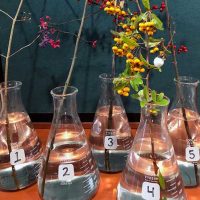Fall Fruits at the Washington Park Arboretum

1) Callicarpa sp. Beautyberry
The small, attractive metallic and purple berries give this ornamental shrub its common name.
The berries stay on the plant late into winter and are an important food source for wildlife.
This popular landscape plant provides a splash of color as fall sets in.
This and other Callicarpa can be seen from Arboretum Drive in our nursery.
All About the Genus Picea

1) Picea orientalis Oriental Spruce
This popular ornamental spruce can grow up to 150 feet and is native to the Caucasus Mountains and northern Asia Minor.
This species is prized for its gracefully pendulous foliage and for the young cones which are deep purple.
A grove of these trees can be found on the northeast side of the Pinetum.
2) Picea morrisonicola Taiwan Spruce
Endemic to the mountains of Taiwan, this spruce has slender, delicate shoots.
Read moreReflections from Rare Care Intern Callie Zender

Over the summer, my fellow intern, Maya Kahn-Abrams, and I monitored twelve species of alpine plants in Olympic and Mount Rainier National Parks. These plants were chosen from a list developed by botanists from each park to describe current status and collect long-term data to develop strategies for adaption to climate change. These species are generally tracked by the Washington Natural Heritage Program, while a majority of them are endemic to Washington State.
Read moreReflections from Rare Care Intern Maya Kahn-Abrams

This year the Rare Plant Care Internship worked with the National Park Service on a project focused on establishing long term monitoring plots in alpine and subalpine ecosystems in Washington state National Parks (Olympic Mountains, Mt. Rainier (Tahoma), and North Cascades). This monitoring programs seeks to understand the effects of climate change on vulnerable alpine/subalpine communities as a whole and rare and largely endemic species in particular.
Read moreA Spotlight on Memorials at the Washington Park Arboretum

Over the years, numerous memorials have been developed in the Arboretum, and several plant collections memorialize individuals. The following are some memorials, and a nearby plant.
1) Camellia japonica ‘Oridono-nishiki’ Foxworthy Benches
This memorial, composed of three benches in memory of Mary Hughes Foxworthy, was installed in 1961 along the trail traversing Rhododendron Glen above the Lookout Gazebo.
There are thousands of cultivars of Camellia japonica in cultivation, with many different colors and forms of flowers.
2019 John A. Wott Endowed Student Award Awarded to Kyra Matin

The John A. Wott Botanic Gardens Endowed Student Award was awarded this spring to Kyra Matin, a second-year Master of Environmental Horticulture student at the University of Washington School of Environmental and Forest Sciences.
As part of her masters project, Kyra is working on several aspects of the New Zealand Forest display in the Pacific Connections Garden at the Washington Park Arboretum.
Late Summer Cuttings from the Washington Park Arboretum

1) Castanea dentata American Chestnut
The American Chestnut, once an important and substantial member of the East Coast hardwood forests, is now all but extinct in the wild due to the chestnut blight that likely arrived from Japan in the 1890s.
Chestnuts are sweet and edible, though hidden inside a prickly burr.
Blight resistant cultivars are still being developed in order to bring back this majestic tree.
Summer Beauty at the Washington Park Arboretum

1) Lagerstroemia indica ‘Muskogee’ Crapemyrtle
Crapemyrtles are beautiful late summer flowering trees with attractive mottled and smooth bark.
This genus has long been popular in southern gardens and is gaining popularity in our urban environment.
This tree can be enjoyed a short walk down Azalea Way from the Graham Visitors Center.
2) Leptospermum lanigerum Wooly Tea-Tree
This common Australian small tree or bush can be found in our Australian collections near the southern end of Arboretum Drive.
Read moreRubus: Berries and Brambles found throughout the Arboretum

1) Rubus armeniacus, Himalayan blackberry
This notorious invasive species was introduced to Washington in the late 1800s for its delicious and prolific berries.
It is often found in disturbed areas and has adapted to wet, dry, sunny, and shady conditions.
2) Rubus leucodermis, blackcap raspberry
This species, native to the West Coast, is known for the dusty white/blue coating on older stems and its arching habit.
Read moreFabulous Fuchsias: Selections from the Chilean Entry Garden

1) Fuchsia magellanica
This is the hardiest of the fuchsia species, and the parent of most hardy fuchsia hybrids.
F. magellanica is native to Chile and Argentina and can reach ten feet in height in moist, frost-protected areas.
This and all featured fuchsias can be found in the Chilean Entry Garden, part of the Pacific Connections Gardens at the southern end of the Washington Park Arboretum.